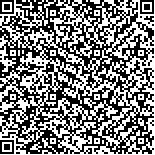本文已被:浏览 778次 下载 420次
Received:April 05, 2017 Published Online:March 23, 2018
Received:April 05, 2017 Published Online:March 23, 2018
中文摘要: 目的:分析血清中性粒细胞明胶酶相关脂质运载蛋白(NGAL)与泛素羧基末端水解酶L1(UCH-L1)水平对预测重度颅脑损伤患者预后的临床价值。方法:选择2015年1月至2016年6月在新疆医科大学第二附属医院就诊的78例重度颅脑损伤患者作为研究对象,根据格拉斯哥昏迷评分(GCS)水平分为:轻症组(41例,GCS评分<9分)和重症组(37例,GCS评分≥9分);随访6个月,依据格拉斯哥预后评分(GOS)将重症组37例分为预后不良组(20例,GOS评分1~3分)和预后良好组(17例,GOS评分4~5分)。采用固相夹心酶联免疫吸附法测定血清NGAL水平,采用酶联免疫吸附(ELISA)法检测血清UCH-L1水平。采用Pearson直线回归分析血清NGAL及UCH-LI与神经功能预后不良的相关性。应用多元Logistic回归分析神经功能预后不良的危险因素。应用受试者工作特征曲线(ROC)判断血清NGAL与UCH-L1水平对重度颅脑损伤患者神经功能预后不良的诊断效能。结果:〓重度组血清NGAL与UCH-L1水平显著高于轻度组(P均<0.01)。随访6个月,重症中预后不良组血清NGAL与UCH-L1水平均高于预后良好组(P均<0.01)。血清NGAL与UCH-L1水平与神经功能预后结局有正相关性(r=0.852,P=0.011;r=0.713,P=0.023)。Logistic回归分析表明血清NGAL水平(OR=3.425,P=0.026)以及血清UCH-L21水平增高(OR=2.698,P=0.038)是神经功能预后不良的危险因素。ROC曲线判定血清NGAL切点为185 ng/ml、UCH-L1切点为16.5 ng/ml时,对预测重度颅脑损伤患者神经功能预后不良的灵敏度为86.9%,特异度为89.5%。结论:血清NGAL与UCH-L1水平能早期评估颅脑损伤程度,可用于短期预后判断。
Abstract:Objective To analyze the clinical value of serum levels of neutrophil gelatinase-associated lipocalin (NGAL) and ubiquitin carboxyl-terminal hydrolase L1 (UCH-L1) for predicting the prognosis of patients with severe craniocerebral injury(SCCI). Methods Seventy-eight SCCI patients admitted in the Second Affiliated Hospital of Xinjiang Medical University from January 2015 to June 2016 were selected as research objects. According to Glasgow coma scale (GCS), the patients were divided into mild group (n=41,GCS score<9) and severe group (n=37,GCS score≥9). According to Glasgow prognostic score (GOS), the patients were divided into poor prognosis group (n=20,GCS score was 1-3). and good prognosis group(n=17,GCS score was 4-5) during the follow-up period of 6 months. Solid-phase sandwich enzyme-linked immunosorbent assay was used to detect serum NGAL level. Enzyme-linked immunosorbent assay (ELISA) was used to detect serum UCH-L1 level. Pearson linear regression analysiswas used to analyze the associations of serum NGAL and UCH-L1 levels with the prognosis of neurological functions. Multivariate logistic regression analysis was used to analyze the risk factors of poor outcome of neurological functions. Receiver operating characteristic curve (ROC) was used to judge the diagnostic capability of serum NGAL and UCH-L1 levels for poor outcome of neurological functions. Results Serum NGAL and UCH-L1 levels in severe group were significantly higher than those in mild group (all P<0.01). During the follow-up period of 6 months, serum NGAL and UCH-L1 levels in poor prognosis group were significantly higher than those in good prognosis group(all P<0.01). Pearson linear regression analysis showed that serum NGAL and UCH-L1 levels were respectively positively correlated with outcome of neurological functions(r=0.852, P=0.011; r=0.713,P=0.023). Multivariate logistic regression analysis showed that the serum levels of NGAL(OR=3. 425,P=0.026) and UCH-L1(OR=2.698,P=0.038) were the risk factors of poor neurological function outcome. When the cut-off points of serum NGAL and UCH-L1 were 185 ng/ml and 16. 5 ng/ml in ROC curve, the sensitivity and the specificity were respectively 86.9% and89.5% for predicting poor neurologic function outcome of SCCI patients. Conclusion Serum NGAL and UCH-L1 levels can early assess the degree of brain injury and can be used for the assessment of short-term prognosis.
keywords: Neutrophil gelatinase-associated lipocalin Ubiquitin carboxyl-terminal hydrolase L1 Craniocerebral injury, severe Prognosis Glasgow coma scale Glasgow prognostic score
文章编号: 中图分类号:R651.1+5 文献标志码:A
基金项目:
| Author Name | Affiliation |
| WANG Jia, ZHANG Hong-yu | Department of Critical Care Medicine, Second Affiliated Hospital of Xinjiang Medical University, Urumqi, Xinjiang 830054, China |
| Author Name | Affiliation |
| WANG Jia, ZHANG Hong-yu | Department of Critical Care Medicine, Second Affiliated Hospital of Xinjiang Medical University, Urumqi, Xinjiang 830054, China |
引用文本:
